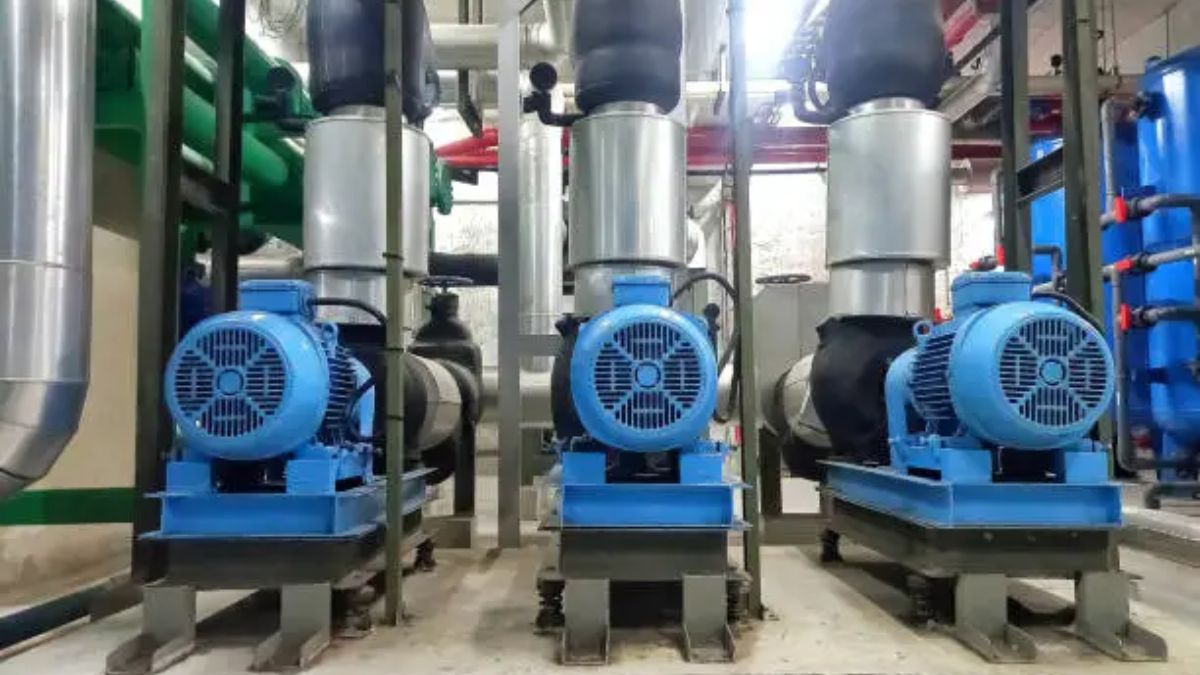TECHNOLOGY
How Deep Offshore Technology Drives Sustainable Oil and Gas Production

Sustainability and energy production may seem an unlikely pair, especially when it comes to oil and gas. Yet, with the advent of deep offshore technology, the industry is turning over a new leaf. Not only does this cutting-edge tech allow for more efficient resource extraction, but it also prioritizes environmental responsibility, paving the way for sustainable practices.
This article dives into how deep offshore technology is revolutionizing oil and gas production, reducing its environmental impact, and supporting global energy demands without sacrificing our planet’s future.
What Is Deep Offshore Technology?
Deep offshore technology refers to sophisticated systems and methods used to explore, extract, and manage oil and natural gas reserves located under the seabed in deep waters (depths of over 1,000 feet). Unlike traditional drilling, deepwater operations require highly advanced technology to overcome extreme conditions such as high pressure, low temperatures, and immense depths.
Some key advancements include autonomous underwater vehicles (AUV), remote-operated vehicles (ROV), and next-generation drilling rigs, which make deepwater exploration more efficient and safer.
But why invest in these complex systems? For one, approximately 30% of the world’s recoverable oil reserves lie beneath deep waters, according to World Oil. This technology unlocks access to resources that were previously unattainable, securing energy for future generations.
Why Sustainability Matters in Oil and Gas
The impact of oil and gas extraction on the environment has been a cause for concern for decades. These operations often lead to greenhouse gas emissions, habitat destruction, and risks of spills that harm marine ecosystems. With growing awareness of climate change and environmental degradation, there is mounting pressure on the industry to adopt sustainable practices.
Governments, stakeholders, and consumers are no longer passive observers. International agreements like the Paris Accord have set ambitious carbon reduction goals. For oil and gas producers, this means incorporating innovation and sustainable practices into their operations—or face obsolescence.
This is where deep offshore technology plays an instrumental role. By leveraging cleaner, more efficient systems, companies can meet energy demands while minimizing their carbon footprint.
The Role of Deep Offshore Technology in Sustainability
1. Enhanced Resource Efficiency
Deepwater operations often use dual-gradient drilling (DGD) technology, which significantly saves energy. DGD manages to control and distribute well pressure better than traditional methods, reducing energy wastage during drilling.
Additionally, advanced reservoir management systems optimize extraction, ensuring that no resources are wasted. These tools improve data collection, allowing decision-makers to pinpoint exactly where and how to drill.
Key takeaway: Efficient use of resources means less irreparable strain on the planet.
2. Minimizing Environmental Impact
Traditional exploration can be disruptive to underwater ecosystems. However, remote-operated vehicles (ROVs) now allow for precise and minimally invasive drilling operations. ROVs are operated from surface vessels and are equipped with high-definition cameras and dexterous robotic arms to carry out essential work underwater without damaging sensitive habitats.
Furthermore, subsea production systems, which relocate key operations from platforms to the ocean floor, reduce surface disruptions. Fewer platforms mean less visual and noise pollution, and lower risks of accidental spills.
Real-world example: BP’s Thunder Horse project in the Gulf of Mexico uses subsea production systems to reduce its ecological footprint while maximizing productivity.
3. Reducing Carbon Output
Deep offshore technology is harnessing renewable energy to power extraction activities. For instance, wind and solar energy are increasingly utilized to run offshore rigs and platforms. Electric-powered systems are replacing diesel engines, reducing emissions considerably.
Automated systems also play a pivotal role in lowering carbon output. AUVs and ROVs operate autonomously or semi-autonomously, consuming less fuel than manned equipment. By optimizing their operations, companies are reducing overall energy consumption.
4. Improved Spill Management
Oil spills are arguably the most devastating consequence of drilling activities, but deep offshore technology is mitigating these risks. Equipment like blowout preventers (BOPs) ensures rapid containment of potential leaks.
Additionally, machine learning algorithms enable predictive maintenance for drilling equipment. These systems can detect anomalies before they escalate, preventing unnecessary shutdowns or failures that could lead to spills.
Did you know? After the Deepwater Horizon disaster in 2010, there was an increased focus on safety and spill prevention in deepwater operations. Today’s technologies continue to improve response times and minimize damages.
Challenges in Implementing Deep Offshore Technology
While promising, deploying deep offshore technology isn’t without its challenges. High costs, technical complexity, and workforce training remain significant barriers for companies exploring sustainable practices.
Deepwater projects are expensive, with upfront investments often reaching billions of dollars. There is also a need for skilled personnel to manage and operate such technologies effectively. Bridging this knowledge gap will require significant investment in training and education.
Regulatory hurdles further complicate matters. Countries and regions often develop conflicting policies about offshore drilling, making it difficult for stakeholders to align their operations with both local and global expectations.
However, as more companies adopt deep offshore technologies, economies of scale may help reduce costs and encourage widespread implementation.
The Future of Deep Offshore Technology
The future looks optimistic for sustainable oil and gas production. Emerging innovations like carbon capture and storage (CCS) are showing promise for reducing environmental impact further. CCS involves trapping carbon emissions from offshore platforms and storing them securely underwater, preventing them from reaching the atmosphere.
Collaborations between technology providers and oil companies are accelerating these innovations. For example, Equinor, Shell, and Total have invested in CCS through their Northern Lights Project, a venture aimed at storing CO2 along the North Sea seabed.
Meanwhile, artificial intelligence and machine learning will continue to play critical roles in analyzing data more effectively, improving decision-making, and further automating operational processes.
What does this mean for the oil and gas industry? Companies that invest in automation, renewable energy integration, and low-impact technologies now stand to gain a competitive edge in the long run.
Driving Toward Sustainability
Deep offshore technology is reshaping the oil and gas industry by proving that environmental sustainability and energy production can coexist. With innovations that prioritize efficiency, reduce carbon emissions, and protect marine ecosystems, the sector is moving toward a cleaner and more responsible future.
But there’s still work to be done. Collaboration across governments, corporations, and technology providers will be crucial for scaling these advancements and achieving lasting impact.
Whether you’re a stakeholder, policymaker, or technology enthusiast, supporting sustainable practices in deep offshore technology today helps secure a better energy future for all.

TECHNOLOGY
Exploring the Features of Xson208: A Comprehensive Review

In a world where technology evolves at lightning speed, keeping up with the latest gadgets can feel overwhelming. Enter the Xson208—a device that promises to be more than just another tech trend. With its blend of cutting-edge features and eye-catching design, the Xson208 has captivated tech enthusiasts and casual users alike. Whether you’re looking for exceptional performance or unique functionalities, this product claims to deliver on all fronts.
But does it really live up to the hype? Let’s dive deep into what makes the Xson208 stand out in a crowded market. From its striking aesthetic appeal to its impressive specs, there’s plenty to explore. Join us as we take an in-depth look at everything this remarkable device has to offer!
Design and Aesthetic Features
The design of the Xson208 stands out in a crowded market. Its sleek lines and modern aesthetic make it an eye-catching addition to any space. The minimalist approach emphasizes functionality without sacrificing style.
Color options are fresh and vibrant, appealing to various tastes. You can easily find a shade that complements your environment, whether it’s home or office.
Materials used in the construction feel premium, enhancing both durability and elegance. Fingerprints? Not a problem here—its surface treatment keeps it looking pristine with minimal effort.
Ergonomics also play a crucial role in the design philosophy. Every curve is intentional, ensuring comfort during extended use while maintaining visual appeal.
The Xson208 doesn’t just perform well; it makes a statement wherever you choose to showcase it.
Performance and Specs
The Xson208 stands out with its impressive performance metrics. Powered by a robust processor, it handles multitasking effortlessly. Whether you’re streaming or gaming, responsiveness is exceptional.
Equipped with ample RAM and storage options, users can store plenty of data without lagging. It supports high-resolution displays, ensuring visuals are crisp and vibrant.
Battery life is another highlight. Users can enjoy extended hours without needing frequent charges. This makes it ideal for on-the-go use.
Additionally, the device boasts advanced cooling technology that prevents overheating during intensive tasks. Gamers will appreciate this feature as it maintains peak performance levels even under pressure.
Connectivity options include the latest Wi-Fi standards and Bluetooth capabilities, allowing seamless interactions with other devices. The Xson208 truly combines power and efficiency in one sleek package.
User-Friendly Interface
Navigating the Xson208 is an experience in simplicity and ease. The interface boasts a clean design that minimizes clutter, allowing users to focus on what matters most.
Buttons are intuitively placed, ensuring quick access to essential functions. Whether you’re tech-savvy or just starting out, you’ll find it easy to maneuver through features without feeling overwhelmed.
Customization options further enhance usability. Users can tailor settings according to their preferences, making the device feel personal and intuitive.
Visual cues guide each step of interaction, providing clarity at every turn. The responsive touch capabilities add another layer of convenience—just a tap brings your commands to life.
With its user-friendly approach, the Xson208 empowers everyone from beginners to seasoned experts alike. It’s not just about functionality; it’s about creating a seamless journey for all who engage with it.
Unique Features and Functions
The Xson208 stands out with its innovative features that elevate the user experience. One remarkable function is its customizable interface. Users can tailor settings according to personal preferences, making navigation a breeze.
Another unique aspect is its multi-device compatibility. Whether you’re using a smartphone, tablet, or laptop, connectivity remains seamless and reliable. This flexibility caters to users who are always on the go.
Additionally, the built-in AI assistant enhances functionality by learning user habits over time. It predicts actions and offers suggestions based on previous interactions.
Security is also prioritized with advanced encryption technology. Your data stays protected while maintaining accessibility across devices.
With these standout functions, the Xson208 proves to be more than just another gadget; it’s designed for modern living in mind.
Comparison with Other Similar Products
When comparing the Xson208 to similar products in its category, it stands out for various reasons. Many alternatives offer basic features, but the Xson208 goes beyond with an innovative design and robust performance metrics.
Competitors might boast about their flashy designs or slightly lower prices, yet they often lack the same level of functionality. The Xson208 integrates advanced technology that enhances user experience significantly.
In terms of specifications, while most rival products focus on one aspect—like speed or graphics—the Xson208 balances multiple facets effectively. This makes it a versatile choice for users seeking reliability across diverse tasks.
Additionally, customer support plays a crucial role in this comparison. The Xson208 provides exceptional after-sales service compared to many competitors who fall short in this area.
Customer Reviews and Ratings
Customer feedback on the Xson208 reveals a mix of satisfaction and critiques. Many users praise its sleek design and intuitive functionality, often highlighting how easy it is to integrate into their daily routines.
Several reviews mention the robust performance, particularly in demanding applications. Users appreciate that it handles multitasking without lag.
However, some have expressed concerns about battery life during intensive use. A few customers noted that while features are impressive, they could drain power more quickly than expected.
Ratings vary across different platforms but generally hover around 4 out of 5 stars. Most users feel confident recommending the Xson208 for both casual and professional settings due to its versatility and reliability.
The community’s overall consensus shows an appreciation for innovation balanced with a desire for improvements in specific areas like durability or energy efficiency.
Pros and Cons of Xson208
The Xson208 boasts several advantages that make it a strong contender in its market. Its sleek design and modern aesthetic appeal attract users right away. Performance-wise, it’s impressive, handling multitasking with ease. Many find the user interface intuitive, making navigation simple even for newcomers.
However, there are some drawbacks worth noting. A few users have reported occasional software glitches that can be frustrating during critical tasks. Additionally, while the build quality is good, some might find it less durable compared to other options available.
Battery life has received mixed feedback; while some appreciate its longevity, others wish it could last longer under heavy use. The price point may deter budget-conscious buyers looking for more affordable alternatives without sacrificing too much functionality.
Final Thoughts and Recommendations
When it comes to the Xson208, there’s a lot to appreciate. Its sleek design attracts attention right away, making it not just functional but also a stylish addition to any tech setup. The performance specs are impressive, catering well to both casual users and those who demand more from their devices.
Navigating through its user-friendly interface feels intuitive, allowing users of all skill levels to make the most of its features without feeling overwhelmed. Unique functions set the Xson208 apart from competitors in this crowded market.
The comparison with similar products shows that while many offer similar capabilities, few can match the combination of aesthetics and performance found here. Customer feedback has been largely positive too; users praise its reliability and ease of use.
Of course, like any product, there are pros and cons worth considering before making a purchase. Weighing these factors helps paint a clearer picture of what you can expect.
If you’re looking for an innovative device that balances style with substance, exploring what the Xson208 offers might be worthwhile. It stands out as a solid choice for anyone seeking quality in their tech investments.
TECHNOLOGY
Laser Hair Removal Buy Machine Checklist: What Every First-Time Buyer Must Know

Many people are now offering laser hair removal services as it is a budget-friendly approach to removing unwanted hair while simultaneously increasing revenue for clinics and spas. If you wish to buy a laser hair removal machine, this guide will assist you in making informed decisions and avoiding traps that will cost you excess money. A common mistake new business owners make is purchasing their equipment from a retail store because they believe it’s cheaper; this is not true, especially when the equipment is bought from spa supplies wholesale stores with certified machines. The above mentioned stores give access to cheaper machines but also come with misleading marketing strategies that divert focus from the actual performance of the machines. Knowing which machine to buy based on the needs of the business can truly be beneficial as it evokes satisfaction and helps save countless amounts of money. Here’s everything to know before buying professional laser hair removal machines that are suitable for your spa.
Skin Safety, Tech Compatibility, & Understanding
The different technologies used in hair removal machines profoundly impact the treatment outcomes, skin compatibility, and safety. Diode lasers are quite popular because of their ideal use over several skin types due to their deep reach and energy balance. Alexandrite lasers with lighter skin tones work best, as they offer quicker treatment times. Darker skin with deeper follicles are best suited to Nd:YAG lasers. There is also IPL (Intense Pulsed Light), a non-laser option, which might work on lighter skin and hair but is widely regarded as less accurate, making it more appropriate for beginner clinics. To maintain safety and effectiveness, it is important to use the appropriate type of laser. The choice of laser should fit the demographics of the clients’ skin colors and hair types to minimize risk and ensure best results. Lastly, devices with advanced cooling features, adjustable parameters, and skin detection sensors greatly mitigate the chances of burns or irritation. Everyone knows that machines need to have FDA, CE, and ISO safety certifications, proving that the equipment has reached international health and safety standards. If you are wholesaling spa supplies, check that your vendor has clear product specs along with the right certification documents.
Request a demonstration or case studies highlighting their clinical outcomes to confirm the performance claims.
Machine Usability and Design Considerations
Using the machine for the first time can be an intimidating experience, which is why most users look for guidance with the proper setup and ergonomic design. Touch screens that allow for treatment presets enhance the treatment accuracy, especially for new users. Additional ease can be offered through protocols enabling technicians to select skin type or body areas for treatment sessions in order to increase consistency across multiple treatments. Weighing the handpieces is important as well; a light and well-balanced handpiece allows for longer treatment time without causing operator strain. Through adjustable spot sizes, both small and large areas can be targeted better, providing better ease and relief to the patient. Software updates are important alongside the ability to change settings since no one wants to work with outdated tech after a year. The addition of training materials is useful as they can come in the form of manuals, online videos, or even live virtual training, enabling the users to operate the device confidently. This approach is especially beneficial when new vendors opt to combine their training materials and accessories with devices which allows the complete set to be delivered in one package. Used as a launching point to advertise a new service, along with targeting reduced spending time, this technique yields great results.
Certain suppliers might provide tailored customer support for your area, guaranteeing that response times are quicker if any problems arise.
Warranty, Maintenance and Long-Term Performance
Usability and reliability over time are considerations equal to initial performance. Laser machines undergo strenuous work, requiring gradual maintenance or replacement of parts such as handpieces, laser heads, and cooling systems. A high-quality machine should provide no less than 1 million pulses per handpiece, with maintenance intervals clearly articulated in the user manual. Inquire from vendors concerning the availability of consumable items such as filters, gels, protective eyewear, and determine the ease of obtaining spare parts locally. Machines featuring low long-term maintenance requirements and high levels of durability minimize service calendar interruptions and reduce costs. Warranties should span a minimum of 12 months after purchase, covering use, parts, and labor, although some suppliers provide additional warranties, upgrades or tiered options. Purchasing through a spa supplies wholesale distributor often provides faster access to support, spare parts and technical diagnostics, aiding in the spa’s operational flow while rapidly resolving potential problems. Inquire with the vendors about backup machines during repairs or onsite servicing. These details, while seeming minor, actually become helpful when a spa is fully operational.
Budgeting ROI, and Choosing the Right Supplier
Pricing is always important for first-time buyers and for spa owners. However, remember that budget concerns should not come ahead of quality, safety, and support. It’s important to understand what value means in conjunction with pricing. Some lower-cost devices tend to compromise quality areas such as Safety and durability or energy stability leading to inconsistent results or even client complaints. Focus on value instead of price alone. How much will this machine benefit you? What is the anticipated lifespan of its servicing? At what rate can the investment be recouped? For instance, in laser hair removal, a session will cost $100 to $300 depending on the market. Using just 30 to 40 treatments can justify the expenditure on a good quality device. This is why it is essential to find reliable spa supplies wholesale vendors. They provide bulk discounts as well and ensure that their clients only receive quality products from reputable manufacturers. Many also offer promotional materials, marketing kits, or clientele consultation tools which aids in quick project initialization. Always include factors like training, maintenance service, and responsiveness in ROI calculations. A vendor with a positively responsive approach contributes to machine performance optimization.
Some even provide entire packages that have several machines or accessories, allowing you to save even more.
Conclusion
For beauty professionals and spa owners venturing into laser hair removal, selecting a machine is among the most important choices of your business. From comprehending technology to client protection and user-friendliness alongside constant care, there are a myriad of necessary factors to consider prior to making a purchase. Opting to laser hair removal buy machine through a trustworthy spa supplies wholesale channel gives you access to not only affordable pricing but also machines that are performance-tested and supported. Take your time, ask questions, and contemplate the long-term visions. The right choice today makes a solid investment for years down the line in client satisfaction and business expansion. Think about building a reputation and concrete results for your brand – the right equipment lays down laser-focused precision to meet your brand vision. The best choice at this stage could drastically lower future costs, preserve clients, and advance the already unrivaled services well above competitors for years unfurling.
TECHNOLOGY
Trends Influencing Electronically Commutated Fans in Industrial Cooling Design

Sustained intelligence and increased focus on sustainability are equally redefining the cooling systems of industrial applications. Recently, the electronically commutated fan market emerged as an important innovation within this context. Reducing operational expense, and energy consumption is a business driver for most industries, and more efficient fans are progressively taking the place of older AC motor based cooling systems.
Also, supporting technologies, like industrial grade thermoelectric cooler wholesale, are starting to gain acceptance in environments where compact, precise, and solid state cooling is required. All these new technologies work in synergy to create new cooling systems units.
This article looks at the business ecosystem surrounding the industrial electric fans manufacture and sales, identifying the leading trends in their industrial adoption and exploring how suppliers and manufacturers can best adapt to this change.
Development of Charge Efficient Cooling Technology
Phrases related to energy saving tend to capture people’s attention and form a great marketing concept, but in reality, it is an important matter these days. Related to other business sectors, cooling systems are important when it comes to examining the company’s carbon footprint. Emission controlling and ESG regulations are with no doubt tightening in importance for almost every manufacturer.
EC Fans Leading the Way
EC fans use direct current (DC) and alternating current (AC) motors in combination, and have integrated electronic controls, allowing for thermal demand regulation. Unlike regular fans, EC fans operate with an adaptive speed control which drastically increases efficiency.
EC fans provide the most efficiency and value in use for HVAC systems, industrial control cabinets, data centers, and telecom enclosures. The demand for cooling in these systems tends to have a varying cyclic pattern through the day.
Unlike conventional fans, EC fans have incorporated thermal management capabilities, resulting in multi-load handling without inhibiting performance, decreased operational noise, heat generation, and overall improved thermal management. Due to these perks, EC fans are perfect for harsh industrial environments where reliability and durability are needed.
Smart Industrial System Integration
Smart infrastructure adoption is enormously popular in industries today, and cooling systems are no exception. There is close association between the market and the adoption trends of ec fans with building management systems and integrating into industrial automation.
Sensor Monitoring and Maintenance
The new units produced for the market now include features such as sensor monitoring and remote control. These features allow maintenance tasks to be completed remotely, greatly improving the accessibility and ease of maintenance tasks.
Integrating EC fans into IoT ecosystems allows for automatic fault notifications, optimized cooling distribution, and dynamic load balancing. These functions mitigate energy costs while preventing downtime, maintenance, and improving the longevity of the system.
Complementary Technologies: The Rise of Thermoelectric Cooling
EC fans are increasingly used with other cooling appliances, such as thermoelectric coolers, which rely heavily on their airflow management capabilities.
The Benefits of Thermoelectric Coolers
Thermoelectric coolers (TECs) are capable of precise temperature regulation utilizing the Peltier effect. Moreover, their absence of moving parts makes them quiet, compact, and exceptionally dependable. TECs are best suited for cooling small enclosures, sensitive electronics, and machinery in harsh, vibration-heavy conditions.
B2B buyers searching for options to buy thermoelectric cooler wholesale can now find customizable and scalable options that seamlessly integrate with EC fan-based airflow systems.
In fact, an epitome encapsulating this synergy would be, “In industrial settings where precision and energy optimization are critical, the electronically commutated fan market and thermoelectric cooler wholesale suppliers are innovating together.”
Diverse Industrial Applications Driving Growth
The retrofitting of EC fans and thermoelectric strategies is being propelled by demand across many verticals. With increased automation and digitization across industries, the need for effective and reliable cooling is becoming more indispensable.
Data Centers and Telecom Infrastructure
Data centers are increasingly adopting EC fans as temperature-sensitive cooling is streamlined in response to the surging data traffic and storage demands. The capability to control fan speed further elevates energy-strain and improves precision in thermal zoning.
Space is at a premium in edge computing and telecom enclosures, along with the sensitivity of the equipment due to heat. The integration of EC fans with thermoelectric cooling creates an ideal solution that is compact, maintenance-free, and easily controllable.
Industrial Automation and Control Cabinets
Control cabinets take the form of drives, PLCs, and power supplies, and encased electronics that create a significant amount of heat. If the internal temperature is not managed properly, significant internal temperatures can cause breakdowns, unplanned downtime, and increase the cost of production.
Incorporating EC fans allows manufacturers to achieve consistent airflow that responds to real-time thermal loads. Integrating thermoelectric cooler wholesale components into these systems improves the temperature accuracy even further without additional mechanical burden.
Medical and Laboratory Equipment
Heat management must not interfere with the operation of medical and analytical instruments, and it needs to be handled as quietly and efficiently as possible. Thermoelectric modules manage essential temperature control in very limited spaces while EC fans provide effective low noise cooling.
This dual approach is now best practice in an increasing number of medical device manufacturing systems because the reliability of these devices directly impacts patient safety.
Sustainability and Global Market Trends
For industrial businesses, sustainability is now a reigning imperative. There is an increased focus on overall organizational performance in relation to carbon footprint, and performance on the environment. Cooling systems are highly scrutinized and have great potential for improvement as one of the most energy-intensive systems.
Regulations Fueling Demand
Sustained government guidelines and voluntary standards (to name a few; Energy Star and ISO 50001) are motivating companies to adopt highly efficient systems. There is a Natural synergy of the EC Fans and Thermoelectric solutions to these regulations providing effortless ways to ace energy audits and reporting compliance.
In conjunction with an increase in the infrastructure of developing markets, the global demand is expected to dramatically rise. The electronically commutated fan market is growing at an unprecedented rate, not just in North America and Europe, but also in the Asia Pacific and Latin American regions.
Simultaneously, wholesale distribution of thermoelectric coolers is expanding to provide more compact and solid-state cooling solutions to both new and retrofit projects.
Innovations and Future Outlook
The enhancements in industrial cooling systems must focus on intelligent control, enhanced integration, and advanced innovation. The need to excel in these aspects have led to rapid advancements in EC fan and thermoelectric technologies.
Hybrid Systems and Modular Cooling
Modular units which combine EC fans and TECs into a single unit are being crafted by manufacturers. These systems can be modularly scaled up or down, depending on the cooling requirements, thus providing unrivaled flexibility and efficacy.
With constant refinements being made, B2B clients can now obtain fully integrated, plug-and-play cooling solutions tailored for specific applications like robotic systems or server enclosures.
AI-Powered Thermal Management
The use of artificial intelligence in cooling control is becoming more prevalent. Based on the historical data available, AI algorithms are capable of anticipating the required cooling demand and will appropriately change the EC fan speed or TEC output, preventing overcooling while maximizing efficiency.
In the future, anticipate self-optimizing and self-monitoring cooling systems that integrate thoroughly into industrial automation systems.
Conclusion
Cooling in the industry is transforming, propelled by changes in the electronically commutated fan market and the increasing availability of thermoelectric cooler wholesale services. For B2B stakeholders, this is a remarkable opportunity to transform their energy expenditure strategies while meeting their eco-friendly goals through effective thermal management.
Businesses that keep track of these trends, collaborate with trusted technology providers, and anticipate the future will be able to design smarter and more efficient cooling systems that endure operational demands for years to come.
-

 NEWS1 month ago
NEWS1 month agoWhat is www.avstarnews.com and What Does It Offer?
-

 TECHNOLOGY2 months ago
TECHNOLOGY2 months agoGomyfinance Invest: Simplify Your Path to Financial Growth
-

 TECHNOLOGY2 months ago
TECHNOLOGY2 months agoAtfboru: A Creative Platform for Designers, Artists, and Entrepreneurs
-

 BUSINESS1 month ago
BUSINESS1 month ago.Ydesi: Exploring Its Significance and Applications
-

 CRYPTO2 months ago
CRYPTO2 months agoCrypto30x.com Gemini: Revolutionize Your Crypto Trading Experience
-

 EDUCATION5 months ago
EDUCATION5 months agothe christian between the gospel and society
-

 ENTERTAINMENT7 months ago
ENTERTAINMENT7 months agoWWE SmackDown Episode 1491: Unforgettable Moments That Left Fans Roaring
-

 HEALTH7 months ago
HEALTH7 months agoEmmyhii777: Unlocking the Power of Positive Social Connections